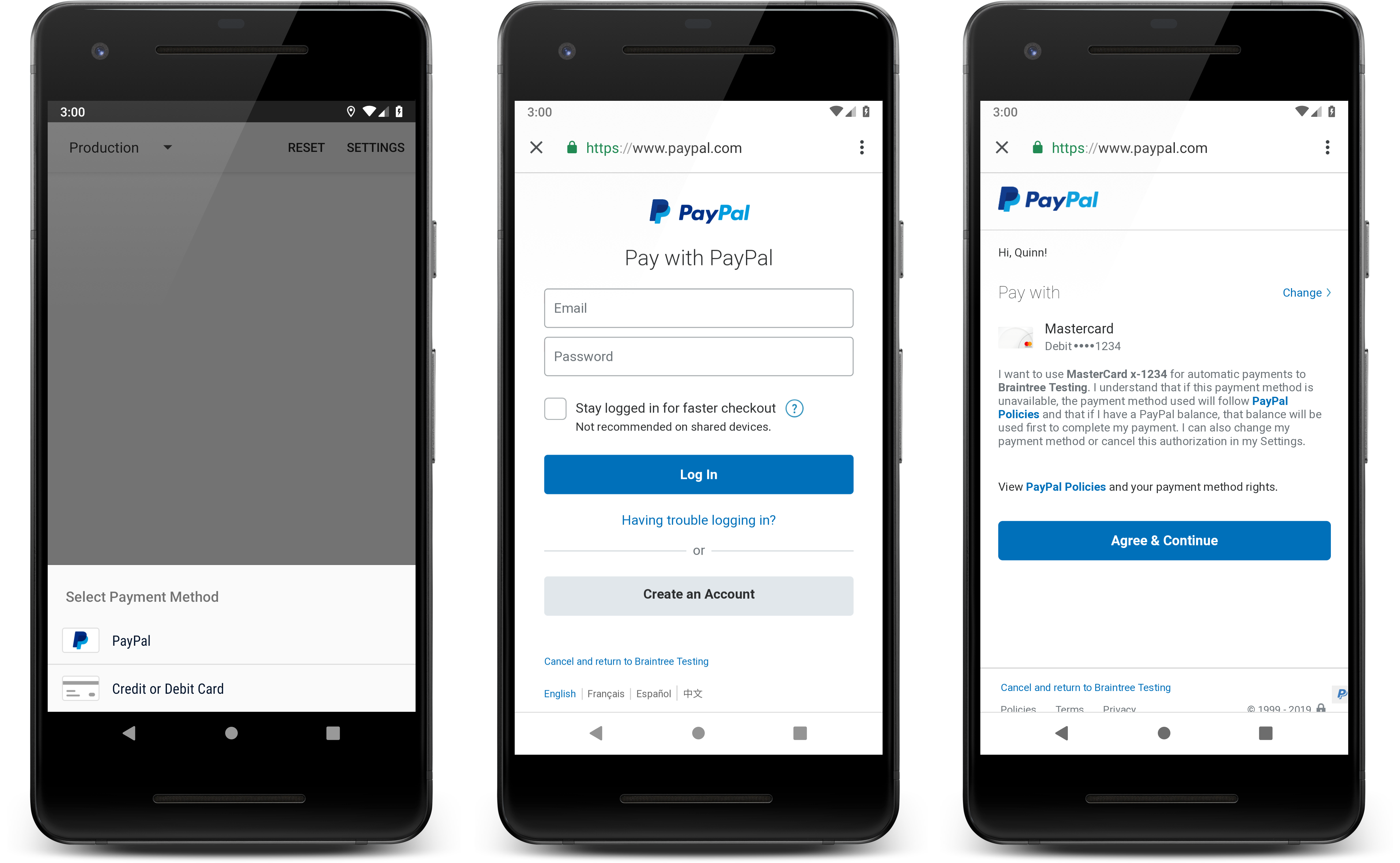PayPal
Vault
Vaulting a PayPal account will allow you to charge the account in the future without requiring your customer to be present during the transaction or re-authenticate with PayPal when they are present during the transaction.
When the customer completes the PayPal authentication flow, the PayPal interface closes and returns the nonce to you in your onPaymentMethodNonceCreated. At this point in time a PayPal pre-approved payment is created between you and the customer, displayed in the customer's account profile on PayPal.com. Send the nonce to your server where it can be used to create a transaction.
The vaulted payment flow supports the following features:
- Select or add shipping addresses in the PayPal account
- Select or add funding instruments in the PayPal account
- Two factor authentication support (currently only for US, UK, CA, DE, AT, and AU)

Typical use cases for the vaulted payment flow:
- Faster payments for repeat customers
- Subscriptions
- Recurring billing (e.g. automatic top-up or usage based charges)
Invoking the Vault flow
First, make sure you have defined your URL scheme. Next, use PayPal#requestBillingAgreement. An example integration might look like this:
- Android
public void startBillingAgreement() {
PayPalRequest request = new PayPalRequest()
.localeCode("US")
.billingAgreementDescription("Your agreement description");
PayPal.requestBillingAgreement(mBraintreeFragment, request);
}When you receive a callback to onPaymentMethodNonceCreated, you can query the PayPalAccountNonce object you get back for specific customer information.
- Android
public void onPaymentMethodNonceCreated(PaymentMethodNonce paymentMethodNonce) {
// Send nonce to server
String nonce = paymentMethodNonce.getNonce();
if (paymentMethodNonce instanceof PayPalAccountNonce) {
PayPalAccountNonce paypalAccountNonce = (PayPalAccountNonce) paymentMethodNonce;
// Access additional information
String email = paypalAccountNonce.getEmail();
String firstName = paypalAccountNonce.getFirstName();
String lastName = paypalAccountNonce.getLastName();
String phone = paypalAccountNonce.getPhone();
// See PostalAddress.java for details
PostalAddress billingAddress = paypalAccountNonce.getBillingAddress();
PostalAddress shippingAddress = paypalAccountNonce.getShippingAddress();
}
}Collecting device data
Collecting device data from your customers is required when initiating non-recurring transactions from Vault records. Collecting and passing this data with transactions will help reduce decline rates.
DataCollector enables you to collect data about a customer's device and correlate it with a session identifier on your server.
Initializing
Drop-in
- Create a
DropInRequestwith a tokenization key or client token from your server.
- Android
DropInRequest dropInRequest = new DropInRequest()
.clientToken(clientToken);- Specify
truefor the device data collection option.
- Android
dropInRequest.collectDeviceData(true);- Start the Drop-in activity.
- Android
startActivityForResult(dropInRequest.getIntent(this), REQUEST_CODE);- Send the device data string response from Drop-in to your server to be included in verification or transaction requests.
- Android
@Override
protected void onActivityResult(int requestCode, int resultCode, Intent data) {
if (requestCode == REQUEST_CODE) {
if (resultCode == RESULT_OK) {
DropInResult result = data.getParcelableExtra(DropInResult.EXTRA_DROP_IN_RESULT);
String deviceData = result.getDeviceData();
}
}
}Custom
-
Initialize a
BraintreeFragmentwith a tokenization key or a client token from your server. -
When verifying a card or creating a transaction call
DataCollector#collectDeviceData.
- Android
DataCollector.collectDeviceData(braintreeFragment, new BraintreeResponseListener<String> {
@Override
public onResponse(String deviceData) {
// send deviceData to your server
}
});- Send the string response from
DataCollector#collectDeviceDatato your server to be included in verification or transaction requests.
Shipping address
Shipping addresses may or may not be collected during the PayPal Vault flow. However, if you choose to collect shipping addresses yourself, it can be passed along with the server side Transaction.Sale call. Look at the Server-side page for more information.
Country and language support
PayPal is available to merchants in all countries that we support and to customers in 140+ countries.
Currency presentment
In the Vault flow itself, the transaction currency and amount are not displayed to the customer. It is up to you to display these details in your checkout flow somewhere (e.g. cart page, order review page, etc.). Our Server-Side guide outlines which currencies are supported for PayPal transactions.
Next Page: Server-side →